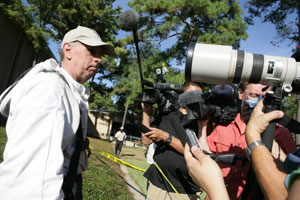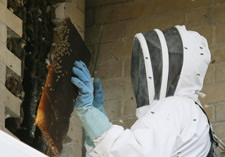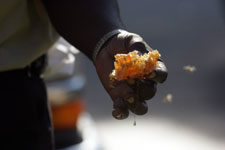The buzz at the University of Houston these days goes beyond the selection of a new chancellor and homecoming plans celebrating the university’s 80th anniversary. More than 100,000 honey bees have taken up residence between the walls of the UH Cullen College of Engineering building, and the university worked today with local bee expert Mike Knuckey to safely remove the hive, which will be relocated to another place on campus.
“Our hope is to safely remove the bees and relocate them to a less populated area on campus,” said Alex Alexander, director of custodial and grounds. “The bee population is already under stress. UH is concerned about the environment we inhabit and will choose to protect it whenever possible. We want to have a safe environment for the students, but we consider these bees a vital part of the campus eco-system and not pests.”
In the wild, honeybees create elaborate hives containing up to 20,000 individuals during the summer months. Domestic hives may have more than 80,000 bees. They work together in a highly structured social order. In the United States alone, it is estimated that honeybees accomplish one-fourth of the pollination needed for all fruit produced for human consumption – an estimated $10 billion worth of work. Since 2006, however, domestic honeybees have suffered a mysterious malady that causes them to leave the hive and not return, leading to the untimely death of the colony. Extensive research is under way to try to determine the cause.
Faculty and students first noticed the bees at UH several months ago on the side of the Engineering building. UH officials speculate the hive takes up a 50- to 100-square-foot area near the top of the building. No one has been stung, though many have seen the bees hovering. Honey also has been seen dripping from weep holes on the side of the building.
In an effort to remove the bees, Knuckey first took temperature readings of the side of the building to determine the exact location of the hive (a higher temperature will indicate bee activity). He then drilled holes into the side of the building and inserted a camera to get a visual confirmation of the bees’ location. After carefully removing some of the brick façade, Knuckey, donned in a protective suit, disoriented the bees with smoke and then removed the hive by hand.
According to Alexander, the hole in the side of the building will remain open for a few days to allow bees and other insects to clean up the residual honey.


